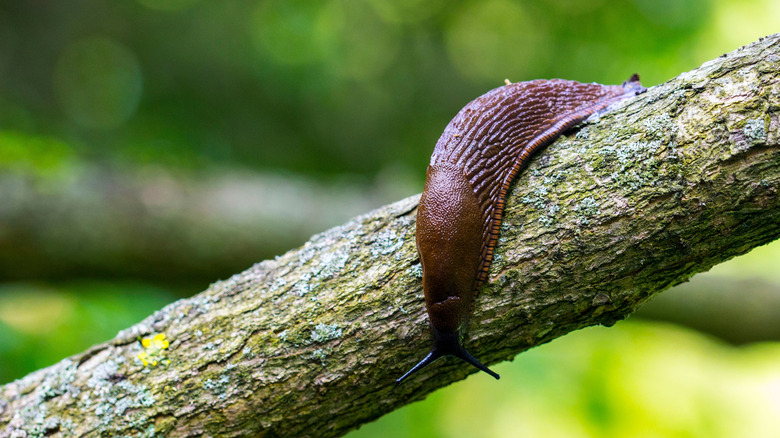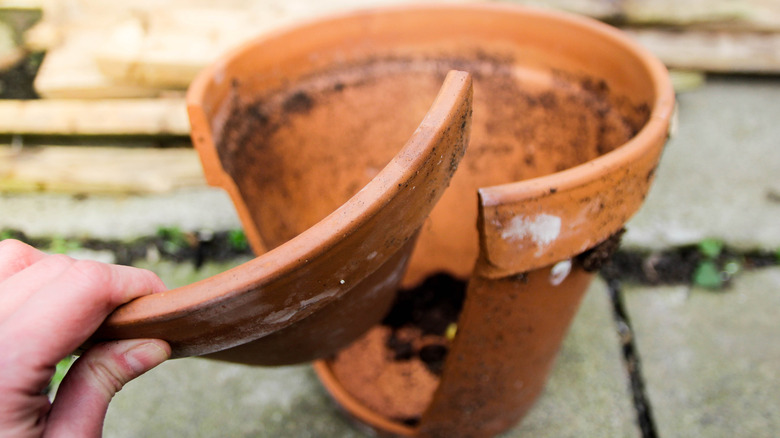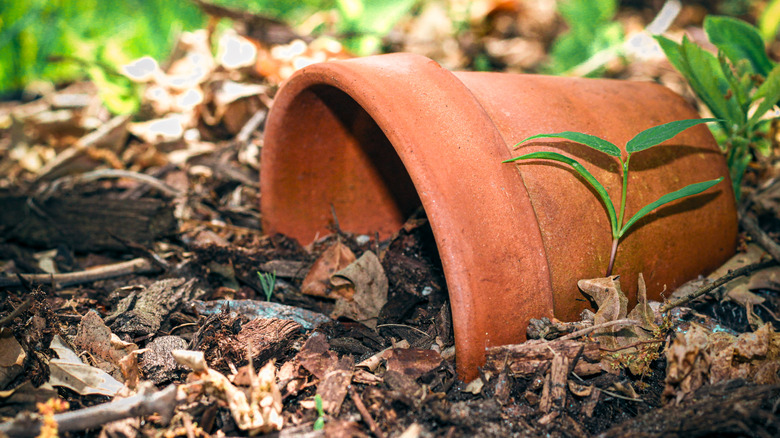Turn Broken Terracotta Planters Into A DIY Mulch That Helps Repel Slugs
For gardeners and plant lovers, it's almost inevitable that a terracotta pot will slip from your grasp and crack open on the ground. It's often not worth attempting to piece the pot back together, but that doesn't mean it has lost its value entirely. If slugs are nibbling your plant leaves, broken pieces of terracotta planter could be the answer to your problems.
One non-toxic tip for keeping snails and slugs out of your garden is hand-picking them. Some people drop them into a bucket of soapy water, too. But this method is tedious and can feel a little cruel. Pity the poor creatures but still don't want them near your plants? A broken pot barrier is a great alternative to diatomaceous earth, which will dehydrate and kill them.
Slugs are not fond of crawling over jagged surfaces. Gardeners fighting off slug incursions are often advised to use crushed eggshells as a deterrent. In this same vein, you can use the sharp pieces from broken clay pots to create a protective, non-toxic, slug-proof barrier around your plants. Rather than harm the slugs, a terracotta shard barrier will simply dissuade them from slithering up to your plants' stems.
How to use broken terracotta pot pieces as a slug barrier
Chances are, unless it was very small, your pot broke into large pieces. Big pieces won't do much to rid your garden beds of slugs. You'll need to crush the existing pieces into smaller chunks. How you crush them is up to you, but make sure to do it outside to minimize the mess. If you want to be extra careful, you can wrap the pieces in an old towel before taking to them with a hammer. To get the most out of your terracotta barrier, don't just scatter the pieces around the base of your plants. Press some into the ground so the sharp edges stick upwards. This creates terrain that slugs find unpleasant. They may be able to crawl over pieces that are laid flat.
To get the most out of your slug barrier, you can also banish pesky slugs from your garden with a clever penny hack. Copper, which pennies contain, is said to repel slugs, though support for its effectiveness is mixed. Scatter the pennies throughout the terracotta pieces or make a few penny balls. Scatter any remaining dull-edged pieces around the garden in a thick layer. Using broken terracotta pots as mulch has benefits outside of defending your garden from slugs. It can keep small animals like squirrels and rabbits from digging up the soil as they hunt for food. Terracotta mulch also traps moisture and warmth in the soil, just like regular mulch, keeping your plants happy.
Create a slug trap with a broken terracotta planter
If your broken terracotta pot is still mostly intact, you can use it to create a chemical-free and humane slug trap. Place the damaged planter upside down in the dirt in a shady part of your garden and cover it with another, larger terracotta pot. The second pot should be unimpaired and have at least one drainage hole. The slugs, seeking someplace warm and moist, will crawl in through the drainage hole and down into the trap. They'll congregate on the walls of the broken pot, allowing you to handpick and remove many slugs from your garden at once.
When looking to defeat slugs in the garden, these defensive measures are great. However, you also need to examine your own gardening practices closely. Some common gardening mistakes that are attracting slugs to your yard include using wooden raised garden beds, over-irrigating, and discouraging critters that eat slugs. Combining tricks like a spiky terracotta barrier or an upturned clay planter trap combined with these adjustments will keep these slimy pests from eating your lettuces and dahlias.


